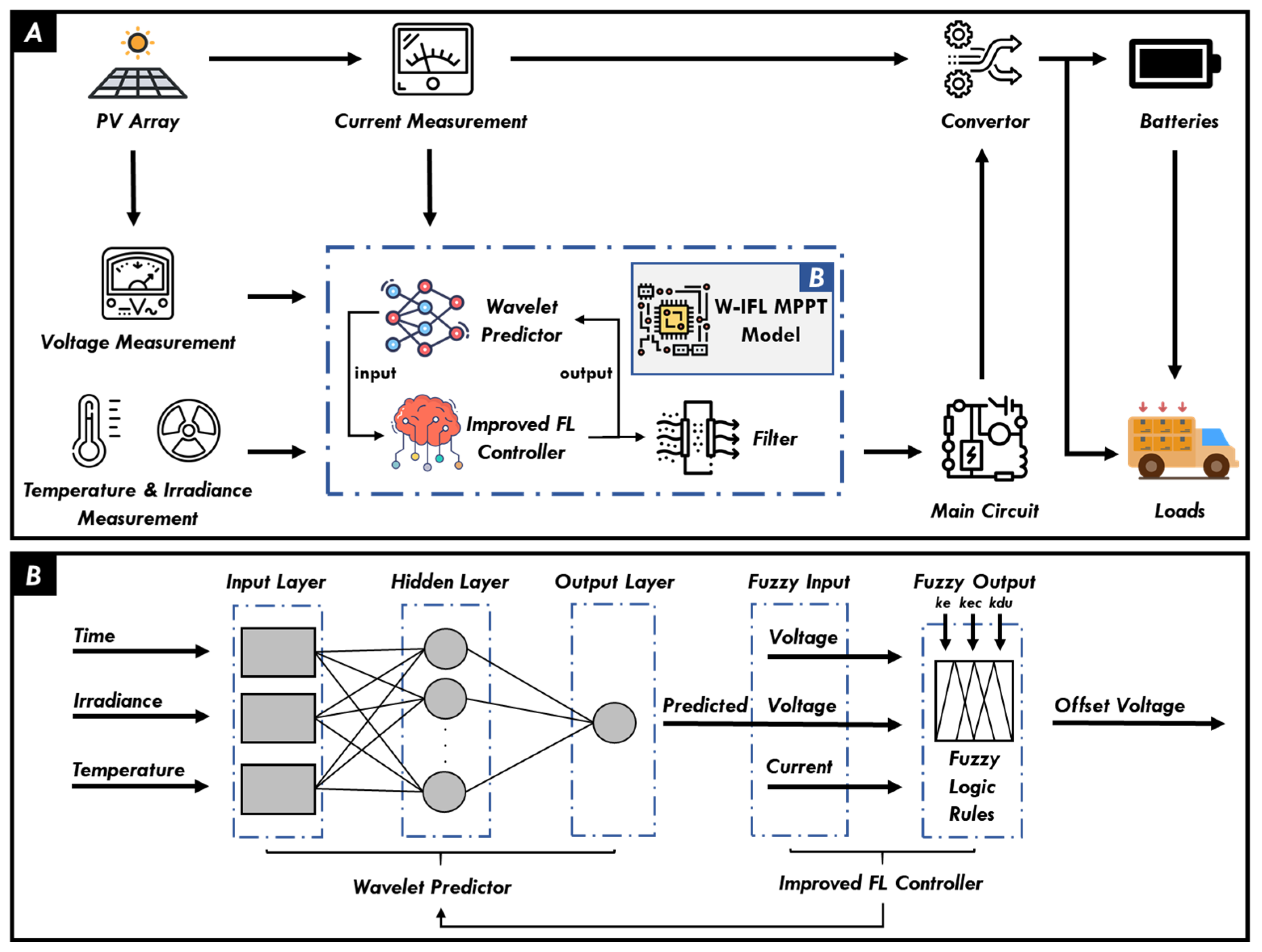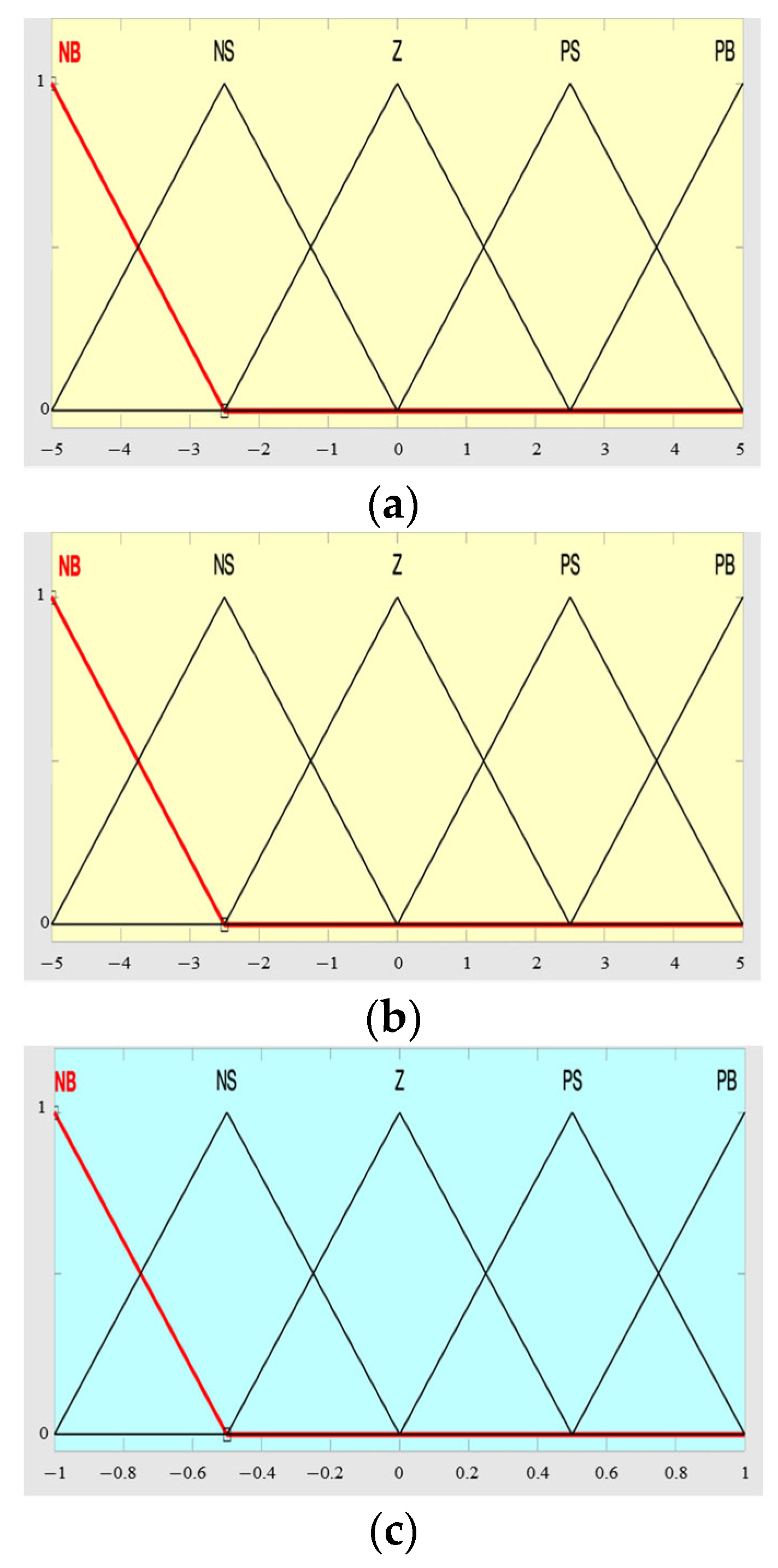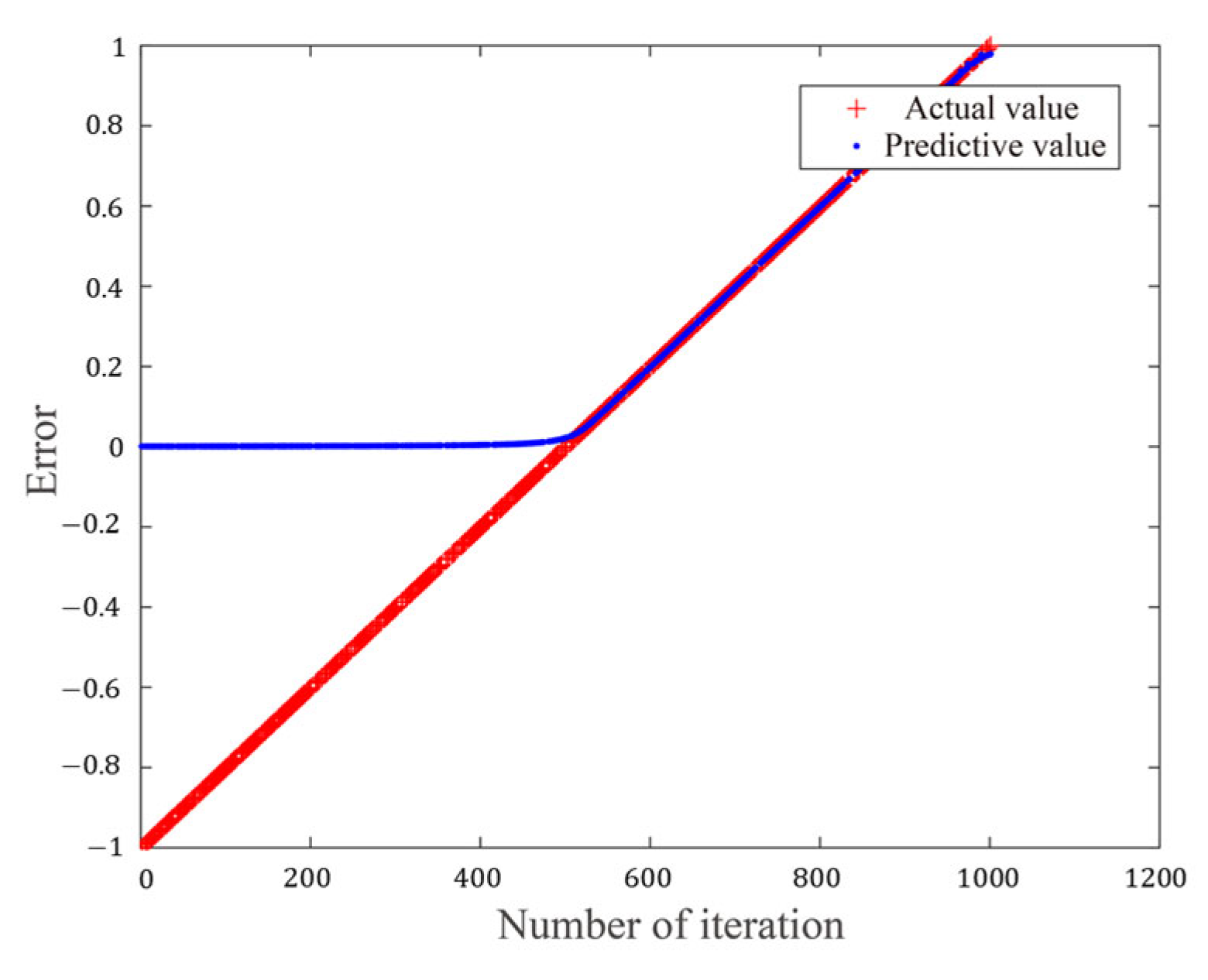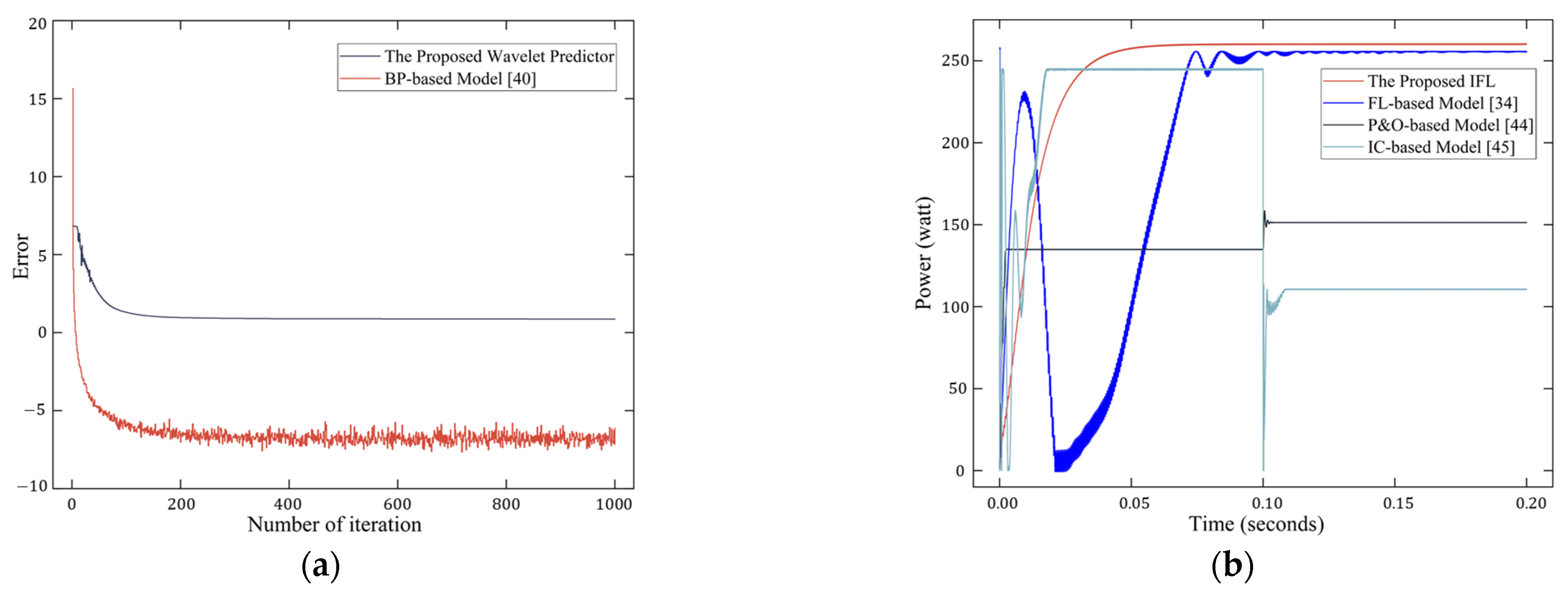W-IFL: An Improved Maximum Power Point Control Model to Promote Renewable-Powered Vehicles
Abstract
1. Introduction
- Compared to existing ANN methods, the wavelet network avoids the subjective selection of hidden layer numbers when processing discrete-time data, which notably reduces the oscillation at the MPP by 50.0%, and efficiently improves the training efficiency and prediction accuracy by 85.7% and 67.7%, respectively;
- Improved fuzzy rules can, accordingly, outperform other control models in terms of tracking speed and accuracy, with average improvements of 55.3% and 62.3%, respectively.
2. Related Works
3. The W-IFL Methodology
3.1. Model Construction
3.2. Wavelet Predictor
3.3. IFL Controller
4. Results & Discuss
4.1. Results
4.2. Discuss
5. Conclusions & Future Works
Author Contributions
Funding
Institutional Review Board Statement
Informed Consent Statement
Data Availability Statement
Conflicts of Interest
References
- Hu, Y.; Li, W.; Xu, K.; Zahid, T.; Qin, F.; Li, C. Energy Management Strategy for a Hybrid Electric Vehicle Based on Deep Reinforcement Learning. Appl. Sci. 2018, 8, 187. [Google Scholar] [CrossRef]
- Sepasgozar, S.; Karimi, R.; Farahzadi, L.; Moezzi, F.; Shirowzhan, S.; M. Ebrahimzadeh, S.; Hui, F.; Aye, L. A Systematic Content Review of Artificial Intelligence and the Internet of Things Applications in Smart Home. Appl. Sci. 2020, 10, 3074. [Google Scholar] [CrossRef]
- Longo, M.; Yaïci, W.; Foiadelli, F. Electric Vehicles Charged with Residential’s Roof Solar Photovoltaic System: A Case Study in Ottawa. In Proceedings of the 2017 IEEE 6th International Conference on Renewable Energy Research and Applications (ICRERA), San Diego, CA, USA, 5–8 November 2017; pp. 121–125. [Google Scholar]
- Kim, S.; Holz, M.; Park, S.; Yoon, Y.; Cho, E.; Yi, J. Future Options for Lightweight Photovoltaic Modules in Electrical Passenger Cars. Sustainability 2021, 13, 2532. [Google Scholar] [CrossRef]
- Sierra Rodriguez, A.; de Santana, T.; MacGill, I.; Ekins-Daukes, N.; Reinders, A. A Feasibility Study of Solar PV-Powered Electric Cars Using an Interdisciplinary Modeling Approach for the Electricity Balance, CO2 Emissions, and Economic Aspects: The Cases of The Netherlands, Norway, Brazil, and Australia. Prog. Photovolt. Res. Appl. 2020, 28, 517–532. [Google Scholar] [CrossRef]
- Anna, Z.; Mikolaj, S.; Andrzej, B. Cooperation of the Process of Charging the Electric Vehicle with the Photovoltaic Cell. In Proceedings of the 2018 Applications of Electromagnetics in Modern Techniques and Medicine (PTZE), Raclawice, Poland, 9–12 September 2018; pp. 285–288. [Google Scholar]
- García Vera, Y.E.; Dufo-López, R.; Bernal-Agustín, J.L. Energy Management in Microgrids with Renewable Energy Sources: A Literature Review. Appl. Sci. 2019, 9, 3854. [Google Scholar] [CrossRef]
- Lai, J.-P.; Chang, Y.-M.; Chen, C.-H.; Pai, P.-F. A Survey of Machine Learning Models in Renewable Energy Predictions. Appl. Sci. 2020, 10, 5975. [Google Scholar] [CrossRef]
- Tina, G.M.; Ventura, C.; Ferlito, S.; De Vito, S. A State-of-Art-Review on Machine-Learning Based Methods for PV. Appl. Sci. 2021, 11, 7550. [Google Scholar] [CrossRef]
- Ma\lek, A.; Marciniak, A. The Use of Deep Recurrent Neural Networks to Predict Performance of Photovoltaic System for Charging Electric Vehicles. Open Eng. 2021, 11, 377–389. [Google Scholar] [CrossRef]
- Pisanti, C. Design and Energetic Evaluation of a Mobile Photovoltaic Roof for Cars. Energy Procedia 2015, 81, 182–192. [Google Scholar] [CrossRef]
- Madeti, S.R.; Singh, S. Monitoring System for Photovoltaic Plants: A Review. Renew. Sustain. Energy Rev. 2017, 67, 1180–1207. [Google Scholar] [CrossRef]
- Lodi, C.; Seitsonen, A.; Paffumi, E.; De Gennaro, M.; Huld, T.; Malfettani, S. Reducing CO2 Emissions of Conventional Fuel Cars by Vehicle Photovoltaic Roofs. Transp. Res. Part Transp. Environ. 2018, 59, 313–324. [Google Scholar] [CrossRef]
- Rekioua, D.; Matagne, E. Optimization of Photovoltaic Power Systems: Modelization, Simulation and Control; Springer Science & Business Media: Berlin/Heidelberg, Germany, 2012. [Google Scholar]
- De Soto, W.; Klein, S.A.; Beckman, W.A. Improvement and Validation of a Model for Photovoltaic Array Performance. Sol. Energy 2006, 80, 78–88. [Google Scholar] [CrossRef]
- Wai, R.-J.; Wang, W.-H.; Lin, C.-Y. High-Performance Stand-Alone Photovoltaic Generation System. IEEE Trans. Ind. Electron. 2008, 55, 240–250. [Google Scholar] [CrossRef]
- Safari, A.; Mekhilef, S. Incremental Conductance MPPT Method for PV Systems. In Proceedings of the 2011 24th Canadian Conference on Electrical and Computer Engineering (CCECE), Niagara Falls, ON, Canada, 8–11 May 2011; pp. 345–347. [Google Scholar]
- Çelikel, R.; Gündoğdu, A. Comparison of PO and INC MPPT Methods Using FPGA In-the-Loop under Different Radiation Conditions. Balk. J. Electr. Comput. Eng. 2021, 9, 114–122. [Google Scholar] [CrossRef]
- Yang, S.-H. MPPT Study of PV System Based on Improved PSO Optimized BP Neural Network Algorithm. In Proceedings of the International Conference on Advanced Algorithms and Neural Networks (AANN 2022), Zhuhai, China, 25–27 February 2022; Volume 12285, pp. 114–120. [Google Scholar]
- Fathi, M.; Parian, J.A. Intelligent MPPT for Photovoltaic Panels Using a Novel Fuzzy Logic and Artificial Neural Networks Based on Evolutionary Algorithms. Energy Rep. 2021, 7, 1338–1348. [Google Scholar] [CrossRef]
- Mohammed, S.S.; Devaraj, D.; Ahamed, T. GA-Optimized Fuzzy-Based MPPT Technique for Abruptly Varying Environmental Conditions. J. Inst. Eng. India Ser. B 2021, 102, 497–508. [Google Scholar] [CrossRef]
- Femia, N.; Petrone, G.; Spagnuolo, G.; Vitelli, M. A Technique for Improving P&O MPPT Performances of Double-Stage Grid-Connected Photovoltaic Systems. IEEE Trans. Ind. Electron. 2009, 56, 4473–4482. [Google Scholar]
- Esram, T.; Chapman, P.L. Comparison of Photovoltaic Array Maximum Power Point Tracking Techniques. IEEE Trans. Energy Convers. 2007, 22, 439–449. [Google Scholar] [CrossRef]
- Femia, N.; Petrone, G.; Spagnuolo, G.; Vitelli, M. Optimization of Perturb and Observe Maximum Power Point Tracking Method. IEEE Trans. Power Electron. 2005, 20, 963–973. [Google Scholar] [CrossRef]
- Li, J.; Wang, H. A Novel Stand-Alone PV Generation System Based on Variable Step Size INC MPPT and SVPWM Control. In Proceedings of the 2009 IEEE 6th International Power Electronics and Motion Control Conference, Wuhan, China, 17–20 May 2009; pp. 2155–2160. [Google Scholar]
- Safari, A.; Mekhilef, S. Simulation and Hardware Implementation of Incremental Conductance MPPT with Direct Control Method Using Cuk Converter. IEEE Trans. Ind. Electron. 2010, 58, 1154–1161. [Google Scholar] [CrossRef]
- Reisi, A.R.; Moradi, M.H.; Jamasb, S. Classification and Comparison of Maximum Power Point Tracking Techniques for Photovoltaic System: A Review. Renew. Sustain. Energy Rev. 2013, 19, 433–443. [Google Scholar] [CrossRef]
- Kamarzaman, N.A.; Tan, C.W. A Comprehensive Review of Maximum Power Point Tracking Algorithms for Photovoltaic Systems. Renew. Sustain. Energy Rev. 2014, 37, 585–598. [Google Scholar] [CrossRef]
- Xiao, W.; Dunford, W.G. A Modified Adaptive Hill Climbing MPPT Method for Photovoltaic Power Systems. In Proceedings of the 2004 IEEE 35th annual power electronics specialists conference (IEEE Cat. No. 04CH37551), Aachen, Germany, 20–25 June 2004; Volume 3, pp. 1957–1963. [Google Scholar]
- Liu, F.; Kang, Y.; Zhang, Y.; Duan, S. Comparison of P&O and Hill Climbing MPPT Methods for Grid-Connected PV Converter. In Proceedings of the 2008 3rd IEEE Conference on Industrial Electronics and Applications, Singapore, 3–5 June 2008; pp. 804–807. [Google Scholar]
- Won, C.-Y.; Kim, D.-H.; Kim, S.-C.; Kim, W.-S.; Kim, H.-S. A New Maximum Power Point Tracker of Photovoltaic Arrays Using Fuzzy Controller. In Proceedings of the 1994 Power Electronics Specialist Conference-PESC’94, Taipei, Taiwan, 30 April 1994; Volume 1, pp. 396–403. [Google Scholar]
- Hiyama, T.; Kouzuma, S.; Imakubo, T. Identification of Optimal Operating Point of PV Modules Using Neural Network for Real Time Maximum Power Tracking Control. IEEE Trans. Energy Convers. 1995, 10, 360–367. [Google Scholar] [CrossRef]
- Anowar, M.H.; Roy, P. A Modified Incremental Conductance Based Photovoltaic MPPT Charge Controller. In Proceedings of the 2019 International Conference on Electrical, Computer and Communication Engineering (ECCE), Cox’s Bazar, Bangladesh, 7–9 February 2019; pp. 1–5. [Google Scholar]
- Zhang, H.; Li, S.; Zhang, X.; Xia, Y. MPPT Control Strategy for Photovoltaic Cells Based on Fuzzy Control. In Proceedings of the 2016 12th International Conference on Natural Computation, Fuzzy Systems and Knowledge Discovery (ICNC-FSKD), Changsha, China, 13–15 August 2016; pp. 450–454. [Google Scholar]
- Punitha, K.; Devaraj, D.; Sakthivel, S. Artificial Neural Network Based Modified Incremental Conductance Algorithm for Maximum Power Point Tracking in Photovoltaic System under Partial Shading Conditions. Energy 2013, 62, 330–340. [Google Scholar] [CrossRef]
- Dkhichi, F.; Oukarfi, B.; Ouoba, D.; Fakkar, A.; Achalhi, A. Behavior of Neural Network MPPT Technique on a PV System Operating under Variable Load and Irradiation. In Proceedings of the 2016 International Conference on Electrical Sciences and Technologies in Maghreb (CISTEM), Marrakesh, Morocco, 26–28 October 2016; pp. 1–4. [Google Scholar]
- Jyothy, L.P.; Sindhu, M. An Artificial Neural Network Based MPPT Algorithm for Solar PV System. In Proceedings of the 2018 4th International Conference on Electrical Energy Systems (ICEES), Kuala Lumpur, Malaysia, 8–9 November 2018; pp. 375–380. [Google Scholar]
- Messalti, S.; Harrag, A.G.; Loukriz, A.E. A New Neural Networks MPPT Controller for PV Systems. In Proceedings of the IREC2015 the Sixth International Renewable Energy Congress, Sousse, Tunisia, 24–26 March 2015; pp. 1–6. [Google Scholar]
- Harrag, A.; Messalti, S.; Daili, Y. Innovative Single Sensor Neural Network PV MPPT. In Proceedings of the 2019 6th International Conference on Control, Decision and Information Technologies (CoDIT), Paris, France, 23–26 April 2019; pp. 1895–1899. [Google Scholar]
- Zhang, Y.; Wang, Y.-J.; Zhang, Y.; Yu, T. Photovoltaic Fuzzy Logical Control MPPT Based on Adaptive Genetic Simulated Annealing Algorithm-Optimized BP Neural Network. Processes 2022, 10, 1411. [Google Scholar] [CrossRef]
- Wu, X.; Huang, Y. Adaptive Fractional-Order Non-Singular Terminal Sliding Mode Control Based on Fuzzy Wavelet Neural Networks for Omnidirectional Mobile Robot Manipulator. ISA Trans. 2022, 121, 258–267. [Google Scholar] [CrossRef]
- Nisar, K.; Sabir, Z.; Raja, M.A.Z.; Ibrahim, A.A.A.; Erdogan, F.; Haque, M.R.; Rodrigues, J.J.; Rawat, D.B. Design of Morlet Wavelet Neural Network for Solving a Class of Singular Pantograph Nonlinear Differential Models. IEEE Access 2021, 9, 77845–77862. [Google Scholar] [CrossRef]
- Ali, M.N.; Mahmoud, K.; Lehtonen, M.; Darwish, M.M. Promising MPPT Methods Combining Metaheuristic, Fuzzy-Logic and ANN Techniques for Grid-Connected Photovoltaic. Sensors 2021, 21, 1244. [Google Scholar] [CrossRef]
- Jagtap, S.; Khandekar, A. Implementation of Combined System between Perturb & Observe and Incremental Conductance Technique for MPPT in PV System. In Proceedings of the 2021 2nd Global Conference for Advancement in Technology (GCAT), Bangalore, India, 1–3 October 2021; pp. 1–6. [Google Scholar]
- Owusu-Nyarko, I.; Elgenedy, M.A.; Abdelsalam, I.; Ahmed, K.H. Modified Variable Step-Size Incremental Conductance MPPT Technique for Photovoltaic Systems. Electronics 2021, 10, 2331. [Google Scholar] [CrossRef]




| Temperature (°C) | Time | Irradiance | PV Cell Output Voltage (V) |
|---|---|---|---|
| 34.0 | 9:24 | 767,000 | 38.53 |
| 34.0 | 9:45 | 785,000 | 37.33 |
| 35.1 | 11:20 | 810,000 | 30.05 |
| 36.0 | 13:39 | 214,000 | 28.19 |
| 34.8 | 14:40 | 1,000,000 | 28.15 |
| 35.0 | 14:43 | 974,000 | 28.01 |
| NB | NS | Z | PS | PB | ||
|---|---|---|---|---|---|---|
| NB | PB | PS | NS | NB | NB | |
| NS | PB | PS | NS | NS | NB | |
| Z | PB | PS | Z | NS | NB | |
| PS | PB | PS | Z | Z | NB | |
| PB | PB | PS | PS | Z | NB | |
Publisher’s Note: MDPI stays neutral with regard to jurisdictional claims in published maps and institutional affiliations. |
© 2022 by the authors. Licensee MDPI, Basel, Switzerland. This article is an open access article distributed under the terms and conditions of the Creative Commons Attribution (CC BY) license (https://creativecommons.org/licenses/by/4.0/).
Share and Cite
Jin, S.; Hao, M.; Cai, M. W-IFL: An Improved Maximum Power Point Control Model to Promote Renewable-Powered Vehicles. Appl. Sci. 2022, 12, 11785. https://doi.org/10.3390/app122211785
Jin S, Hao M, Cai M. W-IFL: An Improved Maximum Power Point Control Model to Promote Renewable-Powered Vehicles. Applied Sciences. 2022; 12(22):11785. https://doi.org/10.3390/app122211785
Chicago/Turabian StyleJin, Shuxin, Mai Hao, and Ming Cai. 2022. "W-IFL: An Improved Maximum Power Point Control Model to Promote Renewable-Powered Vehicles" Applied Sciences 12, no. 22: 11785. https://doi.org/10.3390/app122211785
APA StyleJin, S., Hao, M., & Cai, M. (2022). W-IFL: An Improved Maximum Power Point Control Model to Promote Renewable-Powered Vehicles. Applied Sciences, 12(22), 11785. https://doi.org/10.3390/app122211785







